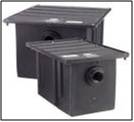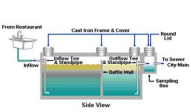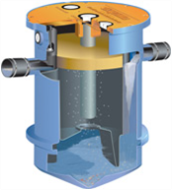Practitioner's Tool / Determining Pretreatment Needs – Grease
Fats, Oil and Grease
Grease is the killer of onsite wastewater treatment systems. If on-site activities include food manufacturing, food service, or utensil washing, grease control systems are required. Three options include an under-the-sink grease trap, an outside grease interceptor, or a hybrid high-capacity grease trap system. Go to the toolkit to look at the three options specific to your facility.
Restaurants generate grease that can clog pipes and add to waste loads. Grease traps or interceptors must be used to prevent clogging. Three types of grease traps or interceptors can be used to prevent clogging depending on the space available and amount of grease produced:
- Under the Sink Grease Trap or Interceptor
- Outdoor Traditional Grease Interceptor
- Super High Capacity Grease Interceptor
Use the tools provided here to help make sound grease trap decisions.
An effective grease management program for restaurants includes
- a properly sized grease trap or grease interceptor,
- procedures for cleaning the grease trap or interceptor on a regular basis,
- storage receptacles for the collected grease,
- grease collection,
- grease recycling and processing into value-added products.
In many locations, organized grease collection and recycling programs are not available, but restaurant owners can work together with elected officials to implement effective community-based grease management programs. Grease is a waste that actually has value as it can be converted into biofuels or other products that can outweigh the cost of collection.
Grease Interceptor Sizing Tool (.xlsm, File 03)
Contents
Types of Grease Traps
Under the Sink Grease Trap or Interceptor
Fats, oils, and grease decompose very slowly after disposal. Worse, when the grease cools, it congeals and causes blockages in the sewer system. Traditional grease traps are placed under sinks with multiple kitchen fixtures connected to separate the grease from wastewater before it gets to the sewer system. It prevents grease from entering the system and clogging it.
Some considerations for a grease trap or interceptor include the following:
- Low initial setup cost--grease traps can be made out of metal or plastic
- Very low space requirement
- Daily cleaning and servicing required, so it can incur high operational costs
- Moderate efficiency--to maintain the required efficiency of the grease trap, operational costs need to be maintained on a routine basis
- Possibility of grease overflowing into wastewater stream during high flow conditions
Outdoor Traditional Grease Interceptor
These grease traps are used when there are larger volumes of grease disposal. The inlet pipe is connected to plumbing fixtures in the building or to an under-sink grease trap. Professional haulers or recyclers are required to clean and maintain this type of grease interceptor because of its large size and for transportation of waste grease to the proper treatment plant.
Considerations for the outdoor grease interceptor include the following:
- High initial setup cost
- Placed outdoors and has a large space requirement
- Moderate operational costs
- Highly efficient when maintained properly
- Septage pumping fees can be high
Super High Capacity Grease Interceptor
This type of interceptor is used in industries like food processing and packaging plants where a very large amount of grease disposal is anticipated (75-5,150 gallons per minute).
Some considerations include the following:
- Moderate initial cost
- Located outdoors but can be above ground for moderate space requirement
- Low operational costs
- Most efficient of the grease traps/interceptors
- Use in conjunction with solids separator or interceptor to maximize efficiency
Proceed to step 5: Determining Pretreatment Needs – Commercial laundry services




